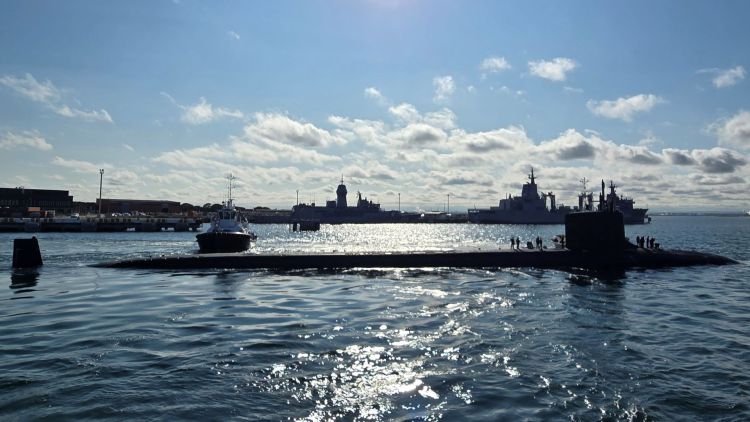Submarines have always played a critical role in national defense, and with increasing global tensions and technological advancements, their importance is only growing.
That’s why the recent Congressional Research Service (CRS) report, released on October 10, 2024, on the US Navy’s Virginia-class submarine program and the AUKUS (Australia – United Kingdom – United States) Pillar 1 submarine project has caught the attention of many.
The updates provided give us a glimpse into the challenges, progress, and strategic decisions shaping the future of submarine defense—not just for America but for its allies like Australia as well.
Here’s what we know on the matter.
What’s Happening with the Virginia-class Submarines?
The US Navy’s Virginia-class submarine program has been a long-running and essential part of our military’s defense capabilities. These nuclear-powered attack submarines have been under procurement since 1998, with a total of 40 Virginia-class submarines (SSNs) already ordered through 2024.
While the Navy has aimed to produce two submarines per year since 2011, recent challenges in workforce availability and supply chains have slowed the production rate to around 1.2 to 1.4 submarines per year since 2022.
These delays are creating a growing backlog of submarines that have been ordered but not yet built.
In response, the Navy and the defense industry are working together to increase production to the original target of two submarines per year by 2028. This would allow them to meet both US defense needs and commitments to the AUKUS program (more on that shortly), which involves selling several Virginia-class submarines to Australia.
Submarines have always played a critical role in national defense, and with increasing global tensions and technological advancements, their importance is only growing.
That’s why the recent Congressional Research Service (CRS) report, released on October 10, 2024, on the US Navy’s Virginia-class submarine program and the AUKUS (Australia – United Kingdom – United States) Pillar 1 submarine project has caught the attention of many.
The updates provided give us a glimpse into the challenges, progress, and strategic decisions shaping the future of submarine defense—not just for America but for its allies like Australia as well.
Here’s what we know on the matter.
What’s Happening with the Virginia-class Submarines?
The US Navy’s Virginia-class submarine program has been a long-running and essential part of our military’s defense capabilities. These nuclear-powered attack submarines have been under procurement since 1998, with a total of 40 Virginia-class submarines (SSNs) already ordered through 2024.
While the Navy has aimed to produce two submarines per year since 2011, recent challenges in workforce availability and supply chains have slowed the production rate to around 1.2 to 1.4 submarines per year since 2022.
These delays are creating a growing backlog of submarines that have been ordered but not yet built.
In response, the Navy and the defense industry are working together to increase production to the original target of two submarines per year by 2028. This would allow them to meet both US defense needs and commitments to the AUKUS program (more on that shortly), which involves selling several Virginia-class submarines to Australia.
In fact, the long-term goal is to eventually produce 2.33 submarines per year to tackle the backlog and meet future requirements.
The proposed 2025 budget includes funding for one Virginia-class submarine, estimated at $5.8 billion. However, the Navy has only requested one submarine this time due to its budget constraints and the current production bottleneck, even though prior budgets had anticipated two submarines for 2025.
The Virginia-class fast attack submarine USS Washington (SSN 787) arrives at Submarine Base New London, September 16, 2024. (DVIDS)
Congress will now need to decide whether to allocate additional funds to support two submarines, which would send a strong signal of the US’s military resolve—especially to potential adversaries like China—and help stabilize the industrial base.
What’s AUKUS Pillar 1 All About?
In addition to US defense needs, the Virginia-class program is also tied to AUKUS, a significant defense partnership between Australia, the United Kingdom, and the United States that was launched in 2021.
The first pillar of this partnership—AUKUS Pillar 1—focuses on the sale and rotational deployment of nuclear-powered submarines to Australia.
Here’s the plan: Australia will buy three to five Virginia-class submarines from the US while the US and UK rotationally deploy their submarines in Western Australia. At the same time, Australia, with help from the US and the UK, will work on building its own fleet of nuclear submarines with a UK-Australian design.
Congress has already approved legislation for this plan as part of the 2024 National Defense Authorization Act.
This project marks a significant development for Australia, giving them access to the kind of nuclear submarine technology that few countries have.
However, it also requires the US to build replacement submarines for its own fleet while navigating a growing backlog of orders.
Balancing the sale of these submarines to Australia with ensuring that the US maintains its own defense capabilities is a delicate dance—and it’s one of the key issues highlighted in the latest report.
You can read the full CRS October 10 report here.
The ASC-Orbis Sibro Partnership: Building Australia’s Future Submarine Capabilities
In an exciting development for the AUKUS program, the Australian Submarine Corporation (ASC) recently announced its first US collaboration partner: Orbis Sibro, a company headquartered in Charleston, South Carolina.
Orbis is well-known for its support of the US nuclear-powered submarine and aircraft carrier programs, so it’s a big win for ASC to bring this expertise to the table.
Orbis will help ASC conduct a “Submarine Rotational Force-West” (SRF-W) Gap Analysis. Essentially, this analysis will identify where Australia’s submarine sustainment program needs to develop, particularly in terms of recruitment and training for its workforce.
This is a critical step because building and maintaining nuclear-powered submarines requires specialized knowledge and skills that Australia will need to grow within its own workforce.
Artist rendering of possible design for SSN-AUKUS submarines. (Wikimedia Commons/BAE Systems)
One of the most interesting aspects of this partnership is that it will involve training placements for ASC’s Australian employees in the US. This means that Australians will come to the US to learn how to maintain Virginia-class submarines, gaining the skills they’ll need to support Australia’s future fleet.
ASC’s CEO, Stuart Whiley, emphasized in a statement that this collaboration is a significant milestone in building Australia’s capabilities and ensuring a sustainable, sovereign nuclear submarine program.
For Orbis, this partnership is equally significant. As Charles Grabenstein, the company’s president, noted, both the US and Australia rely on secure and open sea routes for their national security and economic stability.
Helping Australia build its nuclear submarine fleet is not only a strategic move but also strengthens ties between the two nations as they work together to protect shared interests.
Why Does All This Matter?
At its core, the Virginia-class submarine program and the AUKUS Pillar 1 project represent a significant evolution in how the US and its allies are thinking about defense in an increasingly complex and volatile world.
The US is navigating production challenges while trying to meet its own defense needs and fulfill its commitment to Australia’s security.
Meanwhile, Australia is taking steps to build its own nuclear submarine capabilities for the first time, positioning itself as a key player in the Indo-Pacific region.
The latest report from the Congressional Research Service highlights just how important these submarines are, not only for national defense but also for geopolitical strategy.
The US must find a balance between ensuring it has enough submarines for its fleet while also supporting Australia through the AUKUS project.
For Australia, the partnership with Orbis Sibro marks a crucial step forward in building its submarine sustainment capabilities. By training Australian workers in the US and analyzing what gaps need to be filled, ASC is laying the groundwork for a long-term, self-sufficient submarine program.
Final Thoughts
As these efforts unfold, we’re seeing a powerful example of international collaboration. The US, UK, and Australia are working together to ensure that they can collectively protect their national security interests, all while boosting their technological capabilities and workforce development. It’s a fascinating moment in defense strategy—one that will have lasting implications for years to come.
—
Disclaimer: SOFREP utilizes AI for image generation and article research. Occasionally, it’s like handing a chimpanzee the keys to your liquor cabinet. It’s not always perfect and if a mistake is made, we own up to it full stop. In a world where information comes at us in tidal waves, it is an important tool that helps us sift through the brass for live rounds.



